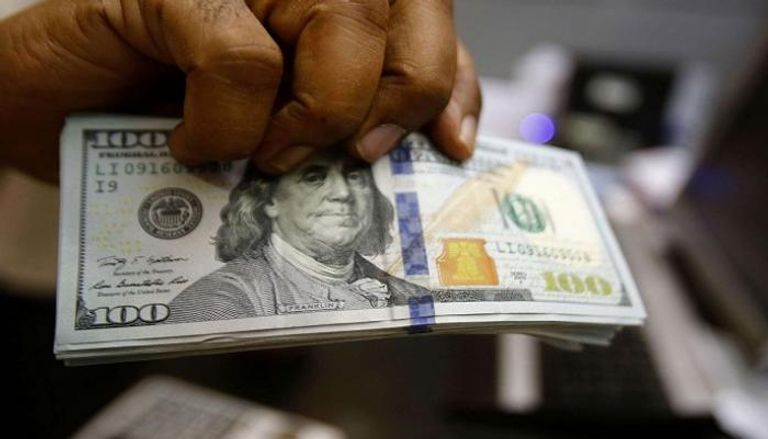أثار تقرير دولي قلق اللبنانيين من احتمال العودة إلى التفلّت في سعر الصرف بعد استقرار مستمر منذ حوالي السنة والنصف، فما هي الأسباب التي قد تفلّت الدولار من عقاله وتضرب قيمة العملة الوطنية؟
في هذا الإطار, يوضح الخبير الاقتصادي ميشال قزح في حديث إلى “ليبانون ديبايت”, أن “قضية ارتفاع سعر الصرف يستوجب طباعة العملة، ولكن مصرف لبنان لا يقوم بالطباعة وهو ما يحول دون التلاعب بسعر الصرف”.
إلا أنه يلفت إلى “النقطة الأهم والتي تتمحور حول العجز بميزان المدفوعات، حيث يتكلّف مصرف لبنان عليه منذ ستة أشهر حوالي 100 مليون دولار للمحافظة على سعر الصرف، وهو يقوم بتغطية هذا الأمر من خلال جباية الدولة للضرائب، فاللبنانيون يدفعون الضرائب بالدولار بعد أن أصبح الإقتصاد مدولر بنسبة كبيرة، حيث يبيع المكلف الدولار عند الصرافين لشراء الليرة اللبنانية حيث تذهب الدولارات إلى المصرف المركزي كذلك الضرائب التي يدفعها المكلف بالليرات التي اشتراها تذهب إلى خزينة الدولة أي إلى مصرف لبنان ويكون المصرف حصل على الدولار والليرة في آن واحد”.
وأضاف, “الدولارت الناتجة عن هذه العملية هي التي يتم بها تغطية الإستيراد، وبالتالي لم يقدم لبنان على القيام بأي شيئ من الإصلاحات، طالما أن ميزان المدفوعات يسجّل عجزاً، لا سيّما أن التجار الذين يستوردون بضائعهم من الخارج يتسببون بنزيف للعملات الصعبة إلى الخارج ولبنان لا يحصل على الدولار إلا من مصدرين من التصدير أو المغتربين يضطر المصرف المركزي إلى تغطية العجز بميزان المدفوعات إما من أموال المودعين الذي اتخذ قرار بعدم المس بهم أو من خلال من جباية الضرائب”.
ويوضح, أن “العجز بميزان المدفوعات يصل اليوم إلى حدود المئة مليون دولار ويصل أحياناً إلى 150 مليون دولار، ولكن بالإطلاع على ميزانية مصرف لبنان فيها خسارة حوالي 600 مليون دولار خلال الستة أشهر الأخيرة، وهذه الأموال يتم تغطيتها من جباية الدولة”.
ويلفت في موضوع زيادة الإحتياط أن زيادته لن تكون بالشكل المطلوب وبدل أن تكون مثلاً مليون و600 مليون تصل فقط إلى مليون لأن الباقي يذهب لتغطية العجز، ذلك لأن الدولة تقوم بجباية ضرائب أكثر من المطلوب جبايتها، فالدولة التي يصل مصروفها إلى 700 مليون تجبي بحدود الـ3 إلى 4 مليار دولار وهذا الفائض يذهب إلى احتياط مصرف لبنان، يهدر منه كمية محددة للحفاظ على استقرار سعر الصرف”.
ويلفت أن “تقرير ستاندر اند بورز وضع في الحسبان تداعيات الحرب وإكمال العجز في ميزان المدفوعات بدون أية إصلاحات، عندها سيصل مصرف لبنان في النهاية إلى استعمال الإحتياط والتي هي ودائع اللبنانيين، وعندما يقرر ذلك عندها يبقى سعر الصرف مستقراً أما إذا استمر برفض المس بالإحتياط سيضطر إلى طباعة العملة عندها سيتدهور سعر الصرف”.
ويوضح “من الناحية العملية أن الإقتصاد في لبنان قد بدأ يسجل نمو وتحسن إلى أن بدأت الحرب في 7 تشرين، والموسم السياحي لم يكن على حجم التوقعات مما يدل عن أن العجز في ميزان المدفواعات سيرتفع، وإذا توسعت الحرب في المنطقة مصرف لبنان سيضطر إلى التدخل بطريقة أكبر لتحرير سعر الصرف, وإذا رفض التدخل سيترك لليرة المجال للتحرر وقد يصل سعر الصرف إلى 120 أو حتى قد يصل إلى 140 الف ليرة”.
ويخلص إلى أن “المشكلة تكمن في ميزان المدفوعات وطباعة الليرة وإذا أراد المصرف المركزي تغيير سياسته الممتنعة عن طباعة الليرة فإنه لن يستطيع أن يهدئ من تدهورها في حال استمر العجز بميزان المدفوعات، وما يمنع هذا السيناريو السيئ هو استعجال عجلة النمو للإقتصاد وأن نحتفظ بكمية دولارات تفوق الكمية المستنزفة في الإستيراد التي تخرج من البلد، لكن اذا استمرينا بحركة إخراج دولارت أكثر من الدولارت التي تدخل البلد سينهار البلد حتماً”.
ويدعو إلى وضع ضوابط على الإستيراد لوقف نزيف الدولارات إلى الخارج واتخاذ قرارات جذرية للحفاظ على التوازن في ميزان المدفوعات والوصول إلى فائض في الصادرات وليس الواردات في المرحلة التالية.
المصدر: ليبانون ديبايت
Major Issue: Dollar Could Reach 140,000 if Situation Worsens!
A recent international report has raised concerns among Lebanese citizens about the potential for a surge in the exchange rate after a period of relative stability lasting approximately a year and a half. What are the reasons behind the potential devaluation of the national currency and the dollar's possible spike?
In this context, economic expert Michel Qazzi explains to “Lebanon Debate” that the issue of exchange rate hikes involves printing money, but the Central Bank of Lebanon is not engaging in this practice, which prevents manipulation of the exchange rate.
He highlights a crucial point related to the balance of payments deficit. For the past six months, the Central Bank of Lebanon has been spending around $100 million to maintain the exchange rate, funding this from state tax revenues. Lebanese taxpayers pay taxes in dollars due to the economy's high dollarization. Taxpayers sell dollars to buy Lebanese lira, which are then deposited into the Central Bank, providing the bank with both dollars and lira.
Qazzi adds, “The dollars resulting from this process are used to cover imports. Lebanon has not undertaken any reforms, and with the balance of payments recording a deficit, traders importing goods cause a drain on foreign currency. Lebanon only obtains dollars from exports or expatriates. The Central Bank has to cover the balance of payments deficit either from depositors’ funds, which it has decided not to touch, or through tax collections.”
He further explains that the balance of payments deficit currently reaches up to $100 million, sometimes $150 million. However, Lebanon’s Central Bank budget shows a loss of around $600 million over the past six months, covered by state tax collections.
On the issue of increasing reserves, Qazzi notes that the increase will not be as expected. Instead of rising to $1.6 billion, it might only reach $1 billion as the surplus is used to cover the deficit. The state collects more taxes than needed, and the excess goes to the Central Bank’s reserves, depleting a portion to maintain exchange rate stability.
Qazzi points out that the S&P report considered the impact of war and the continuation of the balance of payments deficit without any reforms. In such a scenario, the Central Bank might eventually use its reserves, which are the depositors’ funds. If this continues, the exchange rate may become unstable, and if the Central Bank refuses to use the reserves, it might have to print money, leading to a deteriorating exchange rate.
He concludes that the Lebanese economy had begun to show growth and improvement until the war started on October 7. The tourism season did not meet expectations, indicating that the balance of payments deficit will rise. If the war expands in the region, the Central Bank might need to intervene more significantly to stabilize the exchange rate. If it refuses to intervene, the lira may devalue further, potentially reaching 120,000 or even 140,000 lira.
Qazzi suggests that the core issue lies in the balance of payments and currency printing. If the Central Bank changes its policy on printing money, it may not be able to stabilize the currency if the balance of payments deficit persists. To prevent this dire scenario, accelerating economic growth and maintaining a surplus of dollars over the amount spent on imports is essential. If the outflow of dollars exceeds the inflow, the country will inevitably face a crisis.
He calls for imposing restrictions on imports to stop the dollar drain and making decisive decisions to balance the payments and achieve a surplus in exports over imports in the future.
translated by economyscopes team
 سكوبات عالمية إقتصادية – EconomyScopes إجعل موقعنا خيارك ومصدرك الأنسب للأخبار الإقتصادية المحلية والعربية والعالمية على أنواعها بالإضافة الى نشر مجموعة لا بأس بها من فرص العمل في لبنان والشرق الأوسط والعالم
سكوبات عالمية إقتصادية – EconomyScopes إجعل موقعنا خيارك ومصدرك الأنسب للأخبار الإقتصادية المحلية والعربية والعالمية على أنواعها بالإضافة الى نشر مجموعة لا بأس بها من فرص العمل في لبنان والشرق الأوسط والعالم



